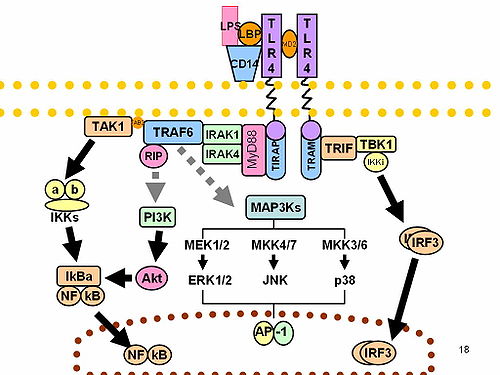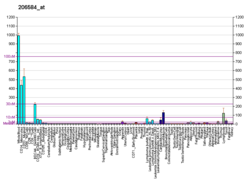リンパ球抗原96
| LY96 | |||||||||||||||||||||||||
|---|---|---|---|---|---|---|---|---|---|---|---|---|---|---|---|---|---|---|---|---|---|---|---|---|---|
 | |||||||||||||||||||||||||
| |||||||||||||||||||||||||
| 識別子 | |||||||||||||||||||||||||
| 記号 | LY96, ESOP-1, MD-2, MD2, ly-96, lymphocyte antigen 96 | ||||||||||||||||||||||||
| 外部ID | OMIM: 605243 MGI: 1341909 HomoloGene: 9109 GeneCards: LY96 | ||||||||||||||||||||||||
| |||||||||||||||||||||||||
| |||||||||||||||||||||||||
| |||||||||||||||||||||||||
| |||||||||||||||||||||||||
| オルソログ | |||||||||||||||||||||||||
| 種 | ヒト | マウス | |||||||||||||||||||||||
| Entrez |
|
| |||||||||||||||||||||||
| Ensembl |
|
| |||||||||||||||||||||||
| UniProt |
|
| |||||||||||||||||||||||
| RefSeq (mRNA) |
|
| |||||||||||||||||||||||
| RefSeq (タンパク質) |
|
| |||||||||||||||||||||||
| 場所 (UCSC) | Chr 8: 73.99 – 74.03 Mb | Chr 8: 16.76 – 16.78 Mb | |||||||||||||||||||||||
| PubMed検索 | [3] | [4] | |||||||||||||||||||||||
| ウィキデータ | |||||||||||||||||||||||||
| |||||||||||||||||||||||||
リンパ球抗原96(リンパきゅうこうげん96、英: Lymphocyte antigen 96)は、ヒトにおいてLY96遺伝子にコードされているタンパク質である[5][6][7]。
この遺伝子にコードされているタンパク質はリポ多糖 (LPS) とToll様受容体4 (TLR4) との結合に関与している。また、"MD2"としても知られている。
相互作用
リンパ球抗原96はTLR4と相互作用をすることが示されている[5][8]。
脚注
- ^ a b c GRCh38: Ensembl release 89: ENSG00000154589 - Ensembl, May 2017
- ^ a b c GRCm38: Ensembl release 89: ENSMUSG00000025779 - Ensembl, May 2017
- ^ Human PubMed Reference:
- ^ Mouse PubMed Reference:
- ^ a b Shimazu, R; Akashi S, Ogata H, Nagai Y, Fukudome K, Miyake K, Kimoto M (Jun. 1999). “MD-2, a Molecule that Confers Lipopolysaccharide Responsiveness on Toll-like Receptor 4”. J. Exp. Med. (United States) 189 (11): 1777–82. doi:10.1084/jem.189.11.1777. ISSN 0022-1007. PMC 2193086. PMID 10359581. https://www.ncbi.nlm.nih.gov/pmc/articles/PMC2193086/.
- ^ Abreu MT, Vora P, Faure E, Thomas LS, Arnold ET, Arditi M (Jul 2001). “Decreased expression of Toll-like receptor-4 and MD-2 correlates with intestinal epithelial cell protection against dysregulated proinflammatory gene expression in response to bacterial lipopolysaccharide”. J. Immunol. 167 (3): 1609–16. PMID 11466383.
- ^ “Entrez Gene: LY96 lymphocyte antigen 96”. 2012年6月20日閲覧。
- ^ Re, Fabio; Strominger Jack L (Jun. 2002). “Monomeric recombinant MD-2 binds toll-like receptor 4 tightly and confers lipopolysaccharide responsiveness”. J. Biol. Chem. (United States) 277 (26): 23427–32. doi:10.1074/jbc.M202554200. ISSN 0021-9258. PMID 11976338.
推薦文献
- Kato K, Morrison AM, Nakano T et al. (2000). “ESOP-1, a secreted protein expressed in the hematopoietic, nervous, and reproductive systems of embryonic and adult mice”. Blood 96 (1): 362–4. PMID 10891475.
- Dziarski R, Wang Q, Miyake K et al. (2001). “MD-2 enables Toll-like receptor 2 (TLR2)-mediated responses to lipopolysaccharide and enhances TLR2-mediated responses to Gram-positive and Gram-negative bacteria and their cell wall components”. J. Immunol. 166 (3): 1938–44. PMID 11160242.
- Schromm AB, Lien E, Henneke P et al. (2001). “Molecular Genetic Analysis of an Endotoxin Nonresponder Mutant Cell Line: A Point Mutation in a Conserved Region of Md-2 Abolishes Endotoxin-Induced Signaling”. J. Exp. Med. 194 (1): 79–88. doi:10.1084/jem.194.1.79. PMC 2193443. PMID 11435474. https://www.ncbi.nlm.nih.gov/pmc/articles/PMC2193443/.
- Visintin A, Mazzoni A, Spitzer JA, Segal DM (2001). “Secreted MD-2 is a large polymeric protein that efficiently confers lipopolysaccharide sensitivity to Toll-like receptor 4”. Proc. Natl. Acad. Sci. U.S.A. 98 (21): 12156–61. doi:10.1073/pnas.211445098. PMC 59784. PMID 11593030. https://www.ncbi.nlm.nih.gov/pmc/articles/PMC59784/.
- Akashi S, Nagai Y, Ogata H et al. (2002). “Human MD-2 confers on mouse Toll-like receptor 4 species-specific lipopolysaccharide recognition”. Int. Immunol. 13 (12): 1595–9. doi:10.1093/intimm/13.12.1595. PMID 11717200.
- Abreu MT, Arnold ET, Thomas LS et al. (2002). “TLR4 and MD-2 expression is regulated by immune-mediated signals in human intestinal epithelial cells”. J. Biol. Chem. 277 (23): 20431–7. doi:10.1074/jbc.M110333200. PMID 11923281.
- Re F, Strominger JL (2002). “Monomeric recombinant MD-2 binds toll-like receptor 4 tightly and confers lipopolysaccharide responsiveness”. J. Biol. Chem. 277 (26): 23427–32. doi:10.1074/jbc.M202554200. PMID 11976338.
- Latz E, Visintin A, Lien E et al. (2003). “Lipopolysaccharide rapidly traffics to and from the Golgi apparatus with the toll-like receptor 4-MD-2-CD14 complex in a process that is distinct from the initiation of signal transduction”. J. Biol. Chem. 277 (49): 47834–43. doi:10.1074/jbc.M207873200. PMID 12324469.
- Strausberg RL, Feingold EA, Grouse LH et al. (2003). “Generation and initial analysis of more than 15,000 full-length human and mouse cDNA sequences”. Proc. Natl. Acad. Sci. U.S.A. 99 (26): 16899–903. doi:10.1073/pnas.242603899. PMC 139241. PMID 12477932. https://www.ncbi.nlm.nih.gov/pmc/articles/PMC139241/.
- Schröder NW, Morath S, Alexander C et al. (2003). “Lipoteichoic acid (LTA) of Streptococcus pneumoniae and Staphylococcus aureus activates immune cells via Toll-like receptor (TLR)-2, lipopolysaccharide-binding protein (LBP), and CD14, whereas TLR-4 and MD-2 are not involved”. J. Biol. Chem. 278 (18): 15587–94. doi:10.1074/jbc.M212829200. PMID 12594207.
- Mullen GE, Kennedy MN, Visintin A et al. (2003). “The role of disulfide bonds in the assembly and function of MD-2”. Proc. Natl. Acad. Sci. U.S.A. 100 (7): 3919–24. doi:10.1073/pnas.0630495100. PMC 153023. PMID 12642668. https://www.ncbi.nlm.nih.gov/pmc/articles/PMC153023/.
- Ohnishi T, Muroi M, Tanamoto K (2004). “MD-2 Is Necessary for the Toll-Like Receptor 4 Protein To Undergo Glycosylation Essential for Its Translocation to the Cell Surface”. Clin. Diagn. Lab. Immunol. 10 (3): 405–10. PMC 154975. PMID 12738639. https://www.ncbi.nlm.nih.gov/pmc/articles/PMC154975/.
- Thompson PA, Tobias PS, Viriyakosol S et al. (2003). “Lipopolysaccharide (LPS)-binding protein inhibits responses to cell-bound LPS”. J. Biol. Chem. 278 (31): 28367–71. doi:10.1074/jbc.M302921200. PMID 12754215.
- Visintin A, Latz E, Monks BG et al. (2004). “Lysines 128 and 132 enable lipopolysaccharide binding to MD-2, leading to Toll-like receptor-4 aggregation and signal transduction”. J. Biol. Chem. 278 (48): 48313–20. doi:10.1074/jbc.M306802200. PMID 12960171.
- Re F, Strominger JL (2004). “Separate functional domains of human MD-2 mediate Toll-like receptor 4-binding and lipopolysaccharide responsiveness”. J. Immunol. 171 (10): 5272–6. PMID 14607928.
- Hamann L, Kumpf O, Müller M et al. (2005). “A coding mutation within the first exon of the human MD-2 gene results in decreased lipopolysaccharide-induced signaling”. Genes Immun. 5 (4): 283–8. doi:10.1038/sj.gene.6364068. PMID 15057266.
- Gruber A, Mancek M, Wagner H et al. (2004). “Structural model of MD-2 and functional role of its basic amino acid clusters involved in cellular lipopolysaccharide recognition”. J. Biol. Chem. 279 (27): 28475–82. doi:10.1074/jbc.M400993200. PMID 15111623.
- Jia HP, Kline JN, Penisten A et al. (2004). “Endotoxin responsiveness of human airway epithelia is limited by low expression of MD-2”. Am. J. Physiol. Lung Cell Mol. Physiol. 287 (2): L428–37. doi:10.1152/ajplung.00377.2003. PMID 15121639.

外部リンク
- lymphocyte antigen 96, human - MeSH・アメリカ国立医学図書館・生命科学用語シソーラス(英語)
- 表示
- 編集











